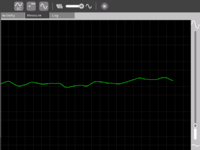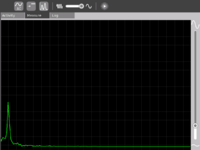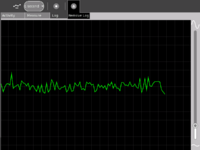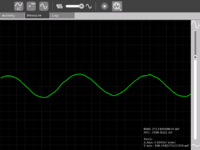Measure: Difference between revisions
(moving projects to Measure/Projects page) |
No edit summary |
||
| Line 10: | Line 10: | ||
{{Olpcboxbottom}} |
{{Olpcboxbottom}} |
||
= '''SAFETY FIRST!''' = |
|||
:::* Make measurements of AC line voltages with the proper equipment only -- for example, a multimeter designed for the purpose. The laptop is not a multimeter. |
:::* Make measurements of AC line voltages with the proper equipment only -- for example, a multimeter designed for the purpose. The laptop is not a multimeter. |
||
[[Image:Caution -- Read and Understand These Instructions.png|left|75px]] |
|||
* '''Read the following article'''. If you don't know what you are doing or are unsure, don't do it. Electricity can be dangerous. |
* '''Read the following article'''. If you don't know what you are doing or are unsure, don't do it. Electricity can be dangerous. |
||
| Line 20: | Line 18: | ||
[[Image:Cautionary warning -- Caution.png|left|50px]] |
[[Image:Cautionary warning -- Caution.png|left|50px]] |
||
'''* CAUTION: RISK OF EQUIPMENT DAMAGE.''' ''DO NOT, UNDER ANY CIRCUMSTANCES, EXCEED THE INPUT AND OUTPUT SPECIFICATIONS; DAMAGE OR DESTRUCTION OF THE EQUIPMENT WILL RESULT. |
|||
= Introduction = |
|||
Children learn by doing things. It is said "Give a child a hammer, and the world becomes his nails". |
Children learn by doing things. It is said "Give a child a hammer, and the world becomes his nails". |
||
This activity is a tool that allows kids to express their curiosity. It is a tool that allows kids to explore and learn by doing, by connecting and observing, span physical phenomena and real world events. Kids would learn by recording and observing the physical phenomena and by connecting their observations to a previously learned concept, or even better - learn the concept based on the experiments and observation. This activity enables children to measure DC and AC voltages by observing them on an oscilloscope-like interface, to watch waveforms in a frequency domain (spectrum analyzer), logging data at a specified time interval and drawing the graph of logged data. |
This activity is a tool that allows kids to express their curiosity. It is a tool that allows kids to explore and learn by doing, by connecting and observing, span physical phenomena and real world events. Kids would learn by recording and observing the physical phenomena and by connecting their observations to a previously learned concept, or even better - learn the concept based on the experiments and observation. This activity enables children to measure DC and AC voltages by observing them on an oscilloscope-like interface, to watch waveforms in a frequency domain (spectrum analyzer), logging data at a specified time interval and drawing the graph of logged data. |
||
= Elements of the Measure activity = |
|||
* There is an 1150 X 800 pixel window in which one sees the waveform. There is a light grey colored grid in the background which is like the scale. |
* There is an 1150 X 800 pixel window in which one sees the waveform. There is a light grey colored grid in the background which is like the scale. |
||
| Line 33: | Line 30: | ||
* ''A Log Toolbar'' which allows one to select the data logging interval, start and stop the logging, and display the log. |
* ''A Log Toolbar'' which allows one to select the data logging interval, start and stop the logging, and display the log. |
||
=Screen shots of Measure Activity= |
|||
{| |
{| |
||
| Line 48: | Line 45: | ||
= Measure Activity activities = |
|||
| Line 63: | Line 60: | ||
(Ideas 1 and 2 given by Erik Blankenship) |
(Ideas 1 and 2 given by Erik Blankenship) |
||
= Downloading and running the Activity on the XO = |
|||
| Line 77: | Line 74: | ||
''Activity has been found running well on build 575 and higher. Since it is a CPU intensive activity, it works best on B3 and B4 machines. Also pre-B4 machines might not fully support the DC mode.'' |
''Activity has been found running well on build 575 and higher. Since it is a CPU intensive activity, it works best on B3 and B4 machines. Also pre-B4 machines might not fully support the DC mode.'' |
||
== Measure Projects == |
|||
# A low cost (possibly $2) probe that would increase the range of voltage that can be applied to the input. |
|||
# An ultrasonic distance measurement system that connects to the XO and allows the XO to log data. This has immense applications in water level monitoring in villages and also in robotics applications. |
|||
# A general purpose hardware kit that interacts with the measure activity. Something on similar lines to http://www.create.ucsb.edu/~dano/CUI/ |
|||
# Sensors could be distributed along with the XO as peripherals. The advantage of this would be that the measure activity can be calibrated against the known specs of the sensors. |
|||
# Being able to measure resistance |
|||
# A low cost version of LEGO mindstorms system built around the XO. The XO has good hardware and software capabilities to achieve this. |
|||
# RS232 or serial interface would allow a host of electronic devices to interact and communicate with the XO. |
|||
# Build a sensor network using a sensor connected to each XO and utilize the mesh networking capability of the XO. This would give us a highly powerful, robust and reconfigurable sensor network. |
|||
# Build medical applications using sensors and the XO. See [[TeleHealth_Module]] |
|||
# Do some Fablab projects using the XO. See http://fab.cba.mit.edu/labs/vigyan/ |
|||
# Collaborative music creation over the mesh using the music software on the XOs and giving input from an array of different sensors. |
|||
# Integrate sensor input into LOGO / Turtle activity |
|||
# Milk purity in rural areas. I remember reading about it in some FabLab's website - I think it requires an ADC, which we have. |
|||
# [[Measure_/_Oscilloscope#Temperature_monitoring_system|Temperature Monitoring and Logging]] |
|||
# [[Measure_/_Oscilloscope#Intrusion_Alarm_system|Intrusion Alarm System]] |
|||
| ⚫ | |||
| ⚫ | |||
| Line 103: | Line 79: | ||
Please see the [[Measure/Projects|Measure Projects page]] to have a look at projects around Measure |
Please see the [[Measure/Projects|Measure Projects page]] to have a look at projects around Measure |
||
= Ways in which software developers can participate= |
|||
=Content and Curriculum= |
|||
| ⚫ | |||
== For content developers == |
|||
== Output and related ideas == |
|||
This page presents a solution for electrical signals to be input to the XO. For the corresponding problem on output, no such solution exists, but there are some ideas at [[Electrical output]]. One idea there is to use the modem connection as finely-timed output - clearly, this would also work for increasing the number of input signals, though it is probably more useful for timing than for fine measurement. |
|||
'''* WARNING: ELECTRICITY CAN KILL'''. ''RISK OF ELECTROCUTION: DO NOT, UNDER ANY CIRCUMSTANCES, APPLY AC LINE VOLTAGES FROM A WALL OUTLET OR MOTOR-GENERATOR OR OTHER POWER SUPPLY (E.G. CONVERTER OR INVERTER) INTO THE MICROPHONE INPUT, THE SPEAKER OUTPUT, OR ANY USB PORT.'' |
|||
:::*''There is a risk of electric shock resulting in death if the XO is used to measure mains voltage by direct connection. The audio input components are not designed for this and damage is likely to result. The extent of the damage is not easily predictable. The only components intended for mains voltage are the pins of the AC adaptor. Dangerous voltages applied to the audio input may also be emitted on audio output, USB connectors, or the DC power input jack.'' |
|||
| ⚫ | |||
| ⚫ | |||
=Software= |
|||
=== Video === |
|||
| ⚫ | |||
Put a video here and some pics |
|||
[[Category:Hardware ideas]] |
|||
[[Category:Software ideas]] |
|||
[[Category:Peripherals]] |
|||
=Acknowledgments= |
|||
Thanks to Mitch Bradley and John Watlington for their help and suggestions during the development of the Activity. |
Thanks to Mitch Bradley and John Watlington for their help and suggestions during the development of the Activity. |
||
=Contact= |
|||
Contact Arjun Sarwal through - |
Contact Arjun Sarwal through - |
||
Revision as of 15:56, 9 January 2008
see more templates or propose new |
SAFETY FIRST!
- Make measurements of AC line voltages with the proper equipment only -- for example, a multimeter designed for the purpose. The laptop is not a multimeter.
- Read the following article. If you don't know what you are doing or are unsure, don't do it. Electricity can be dangerous.
Introduction
Children learn by doing things. It is said "Give a child a hammer, and the world becomes his nails".
This activity is a tool that allows kids to express their curiosity. It is a tool that allows kids to explore and learn by doing, by connecting and observing, span physical phenomena and real world events. Kids would learn by recording and observing the physical phenomena and by connecting their observations to a previously learned concept, or even better - learn the concept based on the experiments and observation. This activity enables children to measure DC and AC voltages by observing them on an oscilloscope-like interface, to watch waveforms in a frequency domain (spectrum analyzer), logging data at a specified time interval and drawing the graph of logged data.
Elements of the Measure activity
- There is an 1150 X 800 pixel window in which one sees the waveform. There is a light grey colored grid in the background which is like the scale.
- Measure Toolbar which allows one to switch between AC and DC modes, toggle Bias Voltage On/Off, view waveform in time domain or frequency domain, select frequency range display, and be able to pause the waveform on the screen.
- A Log Toolbar which allows one to select the data logging interval, start and stop the logging, and display the log.
Screen shots of Measure Activity
Measure Activity activities
- Record animal sounds , for example, sounds of birds and observe their waveforms. Which of these are high frequency sounds, which are the low frequency ones ? Adjust the frequency sliders accordingly.
- Whistle into the mic and compare the loudness and frequency of whistles by observing the waveforms.
- Get two people to try to whistle the same note, and look into Beat Frequencies.
- Turn the sensitivity slider up to the maximum and observe ambient noise - in a quiet room, near a noisy road
- Measure the voltage of an AA size pencil cell. What settings do you use ? AC or DC ?
- Measure resistance of water , other liquids
- Log temperature using a temperature sensor at one hour intervals. When in the day is it the hottest ? The coldest ?
- Some very interesting sensor ideas given by Arnans Roger , see - http://padthai.media.mit.edu:8080/cocoon/gogosite/documentation/makingSensors.xsp?lang=en
(Ideas 1 and 2 given by Erik Blankenship)
Downloading and running the Activity on the XO
The link for the latest version of the activity is http://dev.laptop.org/~arjs/Measure-15.xo . Other previous versions can be found at http://dev.laptop.org/~arjs/
To install the .xo bundle, in the sugar shell (do not do this as root) type
sugar-install-bundle <path>/Measure-15.xo
Activity has been found running well on build 575 and higher. Since it is a CPU intensive activity, it works best on B3 and B4 machines. Also pre-B4 machines might not fully support the DC mode.
Measure Projects
Please see the Measure Projects page to have a look at projects around Measure
Content and Curriculum
Hardware
See the Measure Hardware Details page for hardware details and specs.
Software
Please see the Measure Software page for details on the software and ways to get involved.
Acknowledgments
Thanks to Mitch Bradley and John Watlington for their help and suggestions during the development of the Activity.
Contact
Contact Arjun Sarwal through -
Email : arjun@laptop.org
IRC : arjs on #olpc #sugar




